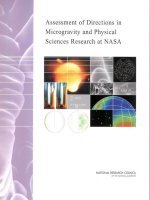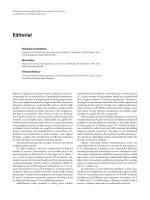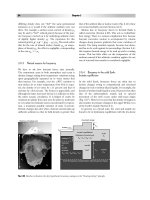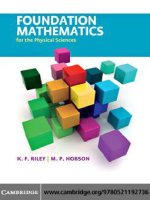3 3 matter (physical sciences)
Bạn đang xem bản rút gọn của tài liệu. Xem và tải ngay bản đầy đủ của tài liệu tại đây (3.01 MB, 12 trang )
Physical Sciences
Standards
Preview
Standard Set 1. Physical Sciences
1. Energy and matter have multiple
forms and can be changed from
one form to another. As a basis for
understanding this concept:
1.i. Students know people once
thought that earth, wind, fire, and
water were the basic elements
that made up all matter. Science
experiments show that there are more
than 100 different types of atoms,
which are presented on the periodic
table of the elements.
Genre
Nonfiction
Comprehension Skill
Sequence
by Arlene Block
Text Features
• Captions
• Glossary
Science Content
Matter
Scott Foresman Science 3.3
ISBN 0-328-23523-7
ì<(sk$m)=cdfcda< +^-Ä-U-Ä-U
Vocabulary
atom
chemical change
element
evaporation
matter
melting
periodic table
property
Picture Credits
Illustrations
12 Big Sesh Studios.
Photographs
Every effort has been made to secure permission and provide appropriate credit for photographic material. The
publisher deeply regrets any omission and pledges to correct errors called to its attention in subsequent editions.
Unless otherwise acknowledged, all photographs are the copyright of DK Images, a division of Pearson.
Photo locators denoted as follows: Top (T), Center (C), Bottom (B), Left (L), Right (R), Background (Bkgd).
Opener: Getty Images; 2 (Bkgd) ©Tony Freeman/PhotoEdit; 8 (B) Michael Hughes/©Aurora Photos; 15 (BL) Digital
Vision, (T) ©Matthew Ward/DK Images; 19 (B) ©Stone/Getty Images.
ISBN: 0-328-23523-7
Copyright © Pearson Education, Inc. All Rights Reserved. Printed in the United States of America.
This publication is protected by Copyright, and permission should be obtained from the publisher prior to any
prohibited reproduction, storage in a retrieval system, or transmission in any form by any means, electronic,
mechanical, photocopying, recording, or likewise. For information regarding permission(s), write to
Permissions Department, Scott Foresman, 1900 East Lake Avenue, Glenview, Illinois 60025.
1 2 3 4 5 6 7 8 9 10 V010 13 12 11 10 09 08 07 06
by Arlene Block
What makes up
matter?
A World of Matter
A property is something you can observe
with one or more of your senses. You can observe
properties of matter. Look at an object. You can tell
its color, shape, or size. Touch an object. You can
tell if it is hard or soft.
Look around. What do you see? Everything
around you is made of matter. Matter is anything
that has mass and takes up space. Mass is the
amount of matter an object has. Pick up an object.
You can feel its mass.
All these objects are
matter. Even the air
inside the balls is
matter.
The hockey puck is
round and smooth.
2
3
Parts of Matter
An element is matter made from a single
Some matter has only atoms of one element.
Aluminum has atoms of only one element. You
type of particle. Each particle is too small to see.
can cut a piece of aluminum foil again and again.
Have you ever used aluminum foil? It is made of
Each new piece is still made of aluminum.
particles of the element aluminum.
An atom is the smallest particle of matter that
Other matter is made of atoms of different
elements. Water is made of atoms of different
has the properties of an element. All matter is
elements. The atoms act together. They give water
made of atoms.
its properties.
Aluminum foil is made of
the atoms of one element.
4
5
Looking At Parts of Matter
You cannot see single atoms with your eyes.
You cannot see atoms with a regular microscope.
Scientists use powerful microscopes to see atoms.
How do atoms combine to make matter? These
This helmet is
made of atoms.
pictures can give you an idea.
of enlarged helmet on page 73
of SE>
This is a picture of
the same helmet. It
is three times as big
as the first picture.
You can use a
microscope to see
matter up close.
73 of SE>
6
Atoms of matter are
like these colored dots.
The dots combine to
form the picture on the
helmet.
7
Changing Ideas About Matter
People have thought about matter since ancient
times. Long ago, people thought all matter was
made of four elements. These elements were earth,
wind, fire, and water.
Since then, scientists have done many
Scientists arrange the elements in a chart. The
chart is called the periodic table. The elements
are arranged according to their properties.
Look at the periodic table below. It shows the
names and symbol of elements. It tells other
information about them. Some elements are
experiments. Today they know there are more than
named after people and places. Einsteinium and
100 different elements. Some matter is made of just
seaborgium are named for famous scientists.
one element. Most matter is made of two or more
Berkelium and californium are named for places.
elements.
Living things are mostly made of four
elements. They are carbon, oxygen,
nitrogen, and hydrogen.
8
9
What are the forms
of matter?
Matter can be in the form of a solid, liquid, or
gas. The particles in these three forms of matter are
always moving.
Solids
A bowling ball is a solid. It keeps its shape.
Particles in a solid stay close together and vibrate.
The particles of a solid are
tightly connected. They
vibrate in place.
Liquids
Orange juice is a liquid. Its shape can change.
It takes the shape of the container it is in. The
amount of space it takes up does not change.
Particles in a liquid flow past each other.
Gases
Air is a gas. It has no shape. The amount
of space it takes up changes. Air fills whatever
space is available. Air is being pumped into the
basketball. Particles in a gas spread out.
The particles of a liquid are
loosely connected. They can
move past one another.
The particles of a gas
are not connected. They
move freely.
10
11
Effects of Heat on Liquids
Matter can change from one form to another.
Effects of Heat on Solid Matter
Heat can change solid matter. Melting is
Heat can change liquid matter. Evaporation
changing from a solid to a liquid. Ice is frozen
is what happens when a liquid changes into a
water. Heat can cause it to melt.
gas. Heat from the air can cause liquid water to
evaporate. It becomes a gas called water vapor.
Taking away heat can change matter that is
a gas. Carbon dioxide is a gas. If it loses enough
heat, it becomes a solid. This solid is called dry ice.
Heat from the air causes
some liquid in this flask to
evaporate.
Heat changes frozen ice
from a solid to a liquid.
12
Heat changes dry ice from
a solid to a gas.
13
Effects of Heat on Metals
Deep inside the Earth it is very hot. It is much
People can use heat to change matter. A welder
heats two pieces of metal until they melt. When
hotter than at the surface. This heat can cause rock
they are cool, the welder joins them together. That’s
to melt. It forms liquid rock called magma. Magma
how this beam was made. Beams like this are
can push up through cracks in the Earth. It can
found in many buildings.
erupt from volcanoes.
Magma that erupts from a volcano is called
Many items in your home were made this way.
Some examples include pots, pans, and the stove.
lava. The liquid lava loses heat on Earth’s surface.
It changes form and becomes solid rock.
Lava erupts from a volcano.
Beams like this are made
from heating metal.
14
15
What are chemical
changes in matter?
Mixing Matter
Forming Different Materials
not taste different. They will not change into a new
To make bread, you need flour, eggs, baking
powder, and yeast. First you mix the ingredients.
Then you bake them in an oven. The heat causes
a chemical change. In a chemical change, one
kind of matter changes into a different kind of
You can cut up lettuce, carrots, and tomatoes.
Then you can mix them together to make a salad.
The ingredients may look different. But they will
kind of matter.
What happens if you mix vinegar
and baking soda? It will make a new
kind of matter. It will make
bubbles that you can see.
matter. The ingredients can never change back to
the form they were. Baking bread is an example of
a chemical change.
Each salad ingredient keeps
its original properties.
16
17
Two Kinds of Changes
A salad is an example of a physical change.
Using Chemical Changes
Chemical changes help us every day. As we eat,
When you cut the vegetables you change their
chemical changes happen to our food. They give
shape. But they stay the same kind of matter—
our body what it needs to grow and stay healthy.
vegetables.
When you add vinegar to baking soda, new
matter forms. It has different properties. It cannot
be changed back into vinegar and baking soda.
That’s because a chemical change happened.
The gasoline in our cars burns. It makes a
chemical change happen. It makes energy to move
the cars.
Do you listen to a portable CD player?
Chemicals combine inside batteries. They make
electricity to help you hear music.
Vinegar and baking soda
form new matter. It has
different properties.
18
19
What did you learn?
Glossary
1. What can you tell about matter?
atom
the smallest particle of matter
that has the properties of an
element
chemical change a change in which one kind
of matter becomes a different
kind of matter
element
matter made up of a single
type of atom
evaporation
when a liquid is changed into
a gas
matter
anything that has mass and
takes up space
melting
changing from a solid to a
liquid
periodic table
a chart with elements
arranged in rows and
columns according to their
properties
property
something about matter that
can be observed with one or
more senses
20
2. What happens when water evaporates?
3. How are a chemical change and a physical change
different?
4.
Write a paragraph to tell
about one form of matter. Develop a topic sentence.
Include facts and details to support your topic sentence.
5.
Sequence What steps would you take to make
bread? List them in order.









